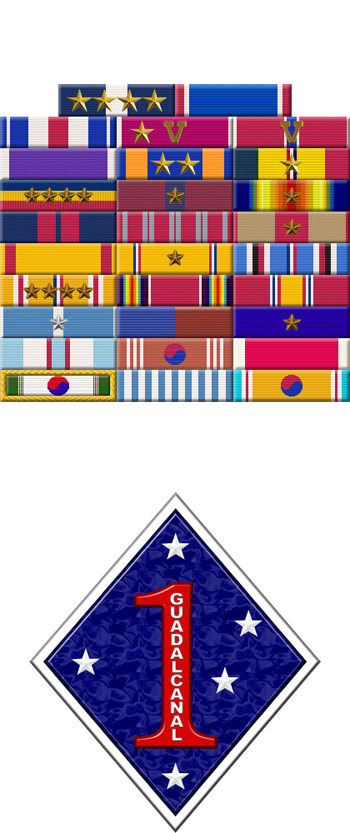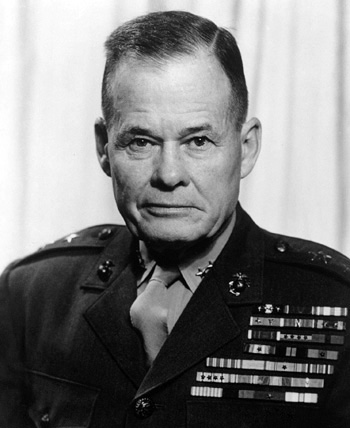
|
Lewis B. Puller |
 |
|||
| Rank, Service | ||||
Lieutenant General O-9, U.S. Marine Corps |
||||
| Veteran of: | ||||
|
||||
| Tribute: | ||||
Chesty Puller was born on June 26, 1898, in West Point, Virginia. He enrolled in the Virginia Military Institute in 1917, but dropped out in August 1918 to enlist in the U.S. Marine Corps, but did not get sent to Europe. He was commissioned a 2d Lt in the Marine Corps Reserve on June 16, 1919, but was placed on inactive duty later that month. He resigned his commission and re-enlisted in the Marines, and then saw action during the Occupation of Haiti from 1919 to 1924. He was recommissioned in March 1924, and served in various stateside assignments before serving with the Marine Barracks at Pearl Harbor, Hawaii, from July 1926 to June 1928. He was briefly assigned to San Diego, California, in 1928, before being sent to Nicaragua in December 1928, where he served until July 1931. Puller attended the Company Officers Course at Fort Benning, Georgia, from August 1931 to June 1932, and then served again in Nicaragua from September 1932 to January 1933. He served with the Marine Detachment at the American Legation in Beijing, China, from February 1933 to 1934, and then served aboard the heavy cruiser USS Augusta (CA-31) until June 1936, when he became an instructor at the Basic School in Philadelphia, Pennsylvania. Puller returned to the USS Augusta in May 1939, followed by service as Executive Officer and then Commanding Officer of the 2nd Battalion, 4th Marines, in China from May 1940 to August 1941. He then took command of 1st Battalion, 7th Marines of the 1st Marine Division at New River (later Camp Lejeune), North Carolina, and deployed with the unit to defend Samoa in May 1942. Col Puller then participated in the Battle of Guadalcanal from September 1942 to February 1943. He then became Executive Officer of the 7th Marine Regiment, and participated in the Battle of Cape Gloucester from December 1943 to January 1944. In February 1944 he became Commander of the 1st Marine Regiment and led them in the Battle of Peleliu in September and October 1944, returning to the U.S. in November 1944. He then served as Executive Officer and then Commanding Officer of the Infantry Training Regiment at Camp Lejeune until August 1946. Puller then served as Director of the 8th Reserve District in New Orleans, Louisiana, from August 1946 to August 1948, and Commander of the Marine Barracks at Pearl Harbor until August 1950. At the beginning of the Korean War, he was once again made Commander of the 1st Marine Regiment, and he led them during the landing at Inchon in September 1950, and during the Battle of Chosin Reservoir in November and December 1950. Gen Puller became Assistant Commander of the 1st Marine Division in January 1951, and served temporarily as its Commander from February to March 1951. He returned to the U.S. in May 1951, and Commanded the 3rd Marine Division at Camp Pendleton, California, from May 1951 to January 1952. He then served as Assistant Division Commander until June 1952, when he took over the Troop Training Unit Pacific at Coronado, California. In July 1954, Gen Puller took command of the 2nd Marine Division at Camp Lejeune, serving until February 1955, when he was appointed Deputy Camp Commander. He retired from the U.S. Marine Corps on November 1, 1955. Chesty Puller died on October 11, 1971, and is buried in Christchurch Parish Cemetery in Christchurch, Virginia. The guided-missile frigate USS Lewis B. Puller (FFG-23) was named in his honor. |
||||
|
||||

